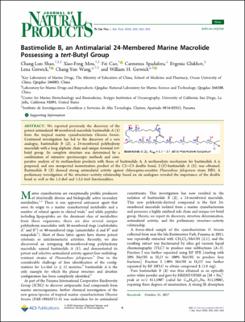| dc.contributor.author | Shao, Chang-Lun | |
| dc.contributor.author | Feng Mou, Xiao | |
| dc.contributor.author | Cao, Fei | |
| dc.contributor.author | Spadafora, Carmenza | |
| dc.contributor.author | Glukhov, Evgenia | |
| dc.contributor.author | Gerwick, Lena | |
| dc.contributor.author | Yun Wang, Chang | |
| dc.contributor.author | Gerwick, William H. | |
| dc.date.accessioned | 2020-06-26T04:51:12Z | |
| dc.date.available | 2020-06-26T04:51:12Z | |
| dc.date.issued | 2018-01-12 | |
| dc.identifier.other | DOI: 10.1021/acs.jnatprod.7b00917 | |
| dc.identifier.uri | http://repositorio-indicasat.org.pa/handle/123456789/119 | |
| dc.description | We reported previously the discovery of the potent antimalarial 40-membered macrolide bastimolide A (1) from the tropical marine cyanobacterium Okeania hirsute. Continued investigation has led to the discovery of a new analogue, bastimolide B (2), a 24-membered polyhydroxy macrolide with a long aliphatic chain and unique terminal tertbutyl group. Its complete structure was determined by a combination of extensive spectroscopic methods and comparative analysis of its methanolysis products with those of bastimolide A. A methanolysis mechanism for bastimolide A is proposed, and one unexpected isomerization product of the C2−C3 double bond, 2-(E)-bastimolide A (3), was obtained. Bastimolide B (2) showed strong antimalarial activity against chloroquine-sensitive Plasmodium falciparum strain HB3. A preliminary investigation of the structure−activity relationship based on six analogues revealed the importance of the double bond as well as the 1,3-diol and 1,3,5-triol functionalities. | en_US |
| dc.description.abstract | We reported previously the discovery of the potent antimalarial 40-membered macrolide bastimolide A (1) from the tropical marine cyanobacterium Okeania hirsute. Continued investigation has led to the discovery of a new analogue, bastimolide B (2), a 24-membered polyhydroxy macrolide with a long aliphatic chain and unique terminal tertbutyl group. Its complete structure was determined by a combination of extensive spectroscopic methods and comparative analysis of its methanolysis products with those of bastimolide A. A methanolysis mechanism for bastimolide A is proposed, and one unexpected isomerization product of the C2−C3 double bond, 2-(E)-bastimolide A (3), was obtained. Bastimolide B (2) showed strong antimalarial activity against chloroquine-sensitive Plasmodium falciparum strain HB3. A preliminary investigation of the structure−activity relationship based on six analogues revealed the importance of the double bond as well as the 1,3-diol and 1,3,5-triol functionalities. | en_US |
| dc.format | Application/pdf | |
| dc.language.iso | eng | en_US |
| dc.rights | https://creativecommons.org/licenses/by/4.0/ | |
| dc.subject | Antimalarial 24-Membered | en_US |
| dc.subject | Marine Macrolide | en_US |
| dc.subject | Possessing a tert-Butyl Group | en_US |
| dc.title | Bastimolide B, an Antimalarial 24-Membered Marine Macrolide Possessing a tert-Butyl Group | en_US |
| dc.type | info:eu-repo/semantics/article | en_US |
| dc.type | Info:eu-repo/semantics/publishedversion | |

